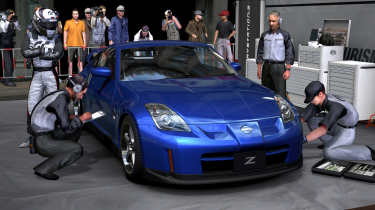Inside sim racing: e-sports driving champions explain it all
We start our virtual engines to explore the world of motorsport simulators with e-sports’ big names
Motor racing has, in principle, stayed very much the same over the past 150 years or so, since the first organised race in the UK was held in Manchester between what were described as “two road steam carriages”. But whether the vehicle is powered by steam, petrol or electricity, the fundamentals remain consistent: the fastest car wins.
Video games, on the other hand, have seen a dramatic transformation over the years. While there almost always remains an ‘objective’ – whether that be to solve a puzzle, slay a horde of zombies or win a race – the sheer complexity and number of games available have exploded over the past few decades. In fact, many people now argue that video games can genuinely be considered as an art form.
Competitive gaming has existed since the days of arcade consoles, but thanks to the rise in popularity of online gaming, so-called ‘e-sports’ have attracted millions of players across different platforms and genres in recent years – including in the category of racing games.
But what is sim racing? Is it just a fad? How does it compare with the real thing, and why should you care? We visited the Gran Turismo World Series in London to find out.
What is sim racing?
Sim racing differs from playing traditional car-racing video games because these ‘games’ are designed to provide players with as much realism as possible, with the ability to race against other players online or in person.
There are numerous sim-racing games out there that can be played either on consoles, such as the PlayStation 5 or Xbox, or on high-end gaming PCs. Some titles will even be exclusive to specific platforms.
The most popular of these, such as Gran Turismo, Assetto Corsa, F1 25 and Rennsport, all have their own major championships with big prize money at stake, as well as the potential of gaining a seat in a real-life racing series.
How realistic is sim racing?
Video games have come a long way from the eight-bit Rad Racer found on the likes of the Nintendo Entertainment System (NES) of the eighties. Many virtual racing games now boast photorealistic graphics and physics engines that aim to accurately replicate the real performance and behaviour of the cars you drive in the game.
We sat down with Valerio Gallo – a contender in the Gran Turismo World Series, plus former FIA GTC Nations Cup World and Olympic Virtual Series champion. He told Auto Express how,just like in real-life motor racing, there is a lot of practice and research that goes into the simulated counterpart.
“You have to consider things like track telemetry, while there’s also each car’s set-up to bear in mind, as well,” Gallo explained. In the World Series, drivers have to manage tyre wear – just as in ‘proper’ motor racing – while cutting the track or causing a collision with another driver can lead to penalties or disqualification from the stewards.
The physics engines of each game can also vary wildly as well, with Gallo pointing out that the same car might handle differently in, say, Gran Turismo than it would in Assetto Corsa. Unlike in traditional motor racing, where drivers typically use just one type of car, the World Series also demands players get behind the (virtual) wheel of a variety of machines from full-on racing cars to traditional road-going models. Gallo tells us that even though it’s on a screen, “you can really feel the difference between different models”.
How fast are sim racers?
It’s difficult to accurately compare the performance of a sim racer with a real-life racing driver, because each will have certain strengths, weaknesses and experience, and as a result, it’s never a completely level playing field.
Nevertheless, it’s important not to dismiss sim racers simply as ‘hardcore gamers’, because achieving strong lap times demands similar track knowledge, car control and racecraft to driving a physical racing car on a track. In fact, the Gran Turismo series creator, Kazunori Yamauchi, even set up the GT Academy in 2008 to develop sim racers into real-life motorsport drivers.
“Back when I started the GT Academy, I was ranked 50th in the world – so pretty competitive,” Yamauchi told Auto Express. “Today, the level of driving has gotten so high that no matter how hard I try to set a lap time, World Series contenders are usually about a second faster than me.”
It’s also important to acknowledge that unlike real racing, there isn’t the same inherent danger factor. If you crash your car, the worst shock your body will go through is a slight vibration through the controller. With this in mind, sim drivers may be more willing to push slightly harder or pull off riskier moves than their real-life counterparts would.
When asked about this difference, Gallo said: “In a game you can pause and restart which, of course, you can’t do in real life. Although, in sim racing we do still have to try and manage strategies and think about the others on the track. Contact can happen very easily, which will still slow you down and is ultimately relatable to real life.”
Why not race real cars?
Following the success of GT Academy, many Gran Turismo players have progressed into real-life motorsport, as have racers playing other titles. But the cost of entry into physical motor racing can potentially run to tens or hundreds of thousand pounds, and limits the numbers.
Gallo told us that e-sports are “arguably the most economical way to go racing”, explaining that while you still need a cockpit, wheel and gaming system, you’re looking at a few thousand pounds rather 10 or 15 times that amount.
Ultimately, getting behind the wheel of a proper race car remains the dream for many. Gallo was candid about his goal of going racing for real and said, “Many of us deserve to be doing this, and to be doing even better than we are.”
Do racing drivers play e-sports?
Many of the most successful racing drivers use sim-racing games to hone their skills. Red Bull Racing’s Max Verstappen is known to stay up late at night before Formula One races to practise on virtual tracks, while Lando Norris frequently live-streams himself playing iRacing, as well as entries from the official F1 series of games. Both drivers even run their own e-sports teams, called Redline and Quadrant respectively.
Verstappen has previously been quoted as saying: “Everyone always thinks that sim racing is just a game and it’s fun, easy going. But I would say the competition is just as hard, or even harder, to nail – to win – than in real life.”
How to get into sim racing
Getting into sim racing is incredibly easy nowadays, because all you really need is a games console or gaming PC and a compatible steering wheel and pedals. At the time of writing, an Xbox Series S or PlayStation 5 will set you back £300 to £340, while an entry-level gaming computer will cost from around £600-800, rising into the thousands for top-spec units.
A steering wheel, on the other hand, can cost anything from £150, all the way into the thousands for high-end controllers made of luxurious materials and boasting direct-drive technology, which can more accurately replicate the feedback one usually feels through a real car’s steering wheel. That’s not to mention a set of pedals and even potentially a sim-racing rig with a seat and brackets to bolt it all into.
From there, find a game you like the most. Do you prefer the ultimate in terms of dynamic realism, or something that’s prettier with a large selection of cars to drive? Practising frequently and turning on features such as racing line guides will help give newbies a better understanding of a track layout, too.
What are the top sim racing games?
Assetto Corsa Competizione
- Platform: PlayStation, Xbox and PC
Developed by Italian studio Kunos, Assetto Corsa has become a well loved sim series, with the ‘Competizione’ version designed to focus entirely on GT racing, with a collection of cars from different manufacturers. All these vehicles have distinct handling characteristics and unique engine sounds.
As you progress through the game, you’ll accumulate a driver rating, which evaluates factors such as how safely you drive, plus your overall race pace and consistency. There are dozens of custom events available to play, while you can easily enter a Quick Race for a short dose of wheel-to-wheel action.
Gran Turismo 7
- Platform: PlayStation
The godfather of sim racing, Gran Turismo practically invented this genre of game. GT7 is the latest entry into the series, with more than 500 customisable cars, stunning graphics, plenty of tracks and a soundtrack of Japanese jazz fusion.
Gran Turismo 7’s ‘Sport Mode’ allows players to instantly dive into daily and weekly custom races, while various time trials give you the opportunity to set the fastest lap times in order to try and win some in-game cash. GT Mode, on the other hand, is a single-player experience that has you racing against AI and earning cash to build your car collection.
F1 25
- Platform: PlayStation, Xbox and PC
If you’ve ever wondered what it feels like to drive a Formula One car, F1 25 is perhaps the closest most of us will get. With updated physics models, commentary and LiDAR-scanned tracks, F1 25 is undoubtedly impressive, with a Formula One Sim Racing championship now taking place every year for players.
The main sim racing is in F1 World mode; this allows players to dive into ranked races and full GP weekend simulations. My Team is a single-player mode that lets you build and run your own team, while Braking Point is a story-mode game with in-race objectives.
Le Mans Ultimate
- Platform: PC
Released earlier in 2025, Le Mans Ultimate is one of the newest sim-racing games and aims to accurately replicate the World Endurance Championship in digital form. The game currently features all the tracks on the 2023 WEC calendar, as well as the Hypercars and GT3 cars that competed that season.
As with other racing sims, there are daily races you can sign up for – these take place roughly every 30 minutes and can last anything from 20 minutes to a couple of hours, playing heavily on the ‘endurance racing’ theme. There’s even a single-player mode for those who want to play alone.
iRacing
- Platform: PC
Arguably one of the most realistic racing sims currently available, what iRacing lacks in visual fidelity and ability to drive non-racing cars, it makes up for with a meticulous physics engine that accurately replicates car dynamics and behaviour.
Drivers start out in the Rookie class, which limits them to the slowest cars available as they learn the ropes. You can then purchase cars – with real money, might we add – in order to get access to other race series. Players can compete in both ranked and non-ranked races, which are scheduled daily and run frequently.
Get even more from Auto Express, follow our channels...
Find a car with the experts









